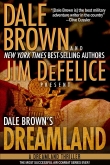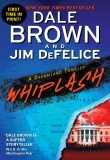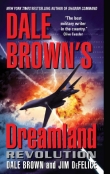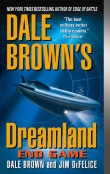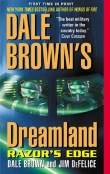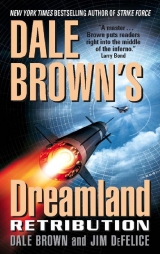
Текст книги "Retribution"
Автор книги: Dale Brown
Жанр:
Боевики
сообщить о нарушении
Текущая страница: 1 (всего у книги 23 страниц)


DALE
BROWN’S
Dreamland
RETRIBUTION
DALE BROWN and JIM DEFELICE
Contents
Dreamland: Duty Roster
v
From the Authors: The Story so Far …
vii
Prelude: Annihilation Averted 1
I: Downed Airmen 7
II: Lost and Not Found 49
III: Finders Keepers 91
IV: New Sheriff in Town 137
V: Long Day’s Night 197
VI: Borrowed Time 243
VII: No Chance to Survive 287
VIII: Homecoming 327
IX: Payments Due 347
X: The Long Ride Home 383
About the Authors
Praise
Other Books in the Dreamland Series
Cover
Copyright
About the Publisher
Dreamland: Duty Roster
Lieutenant Col o nel Tecumseh “Dog” Bastian Dreamland’s commander has been mellowed by the demands of his new command—but he’s still got the mean-est bark in the West, and his bite is even worse.
Major Jeffrey “Zen” Stockard
A top fighter pilot until a crash at Dreamland left him a paraplegic, Zen has volunteered for a medical program that may let him use his legs again. Can Dreamland survive with a key member away?
Captain Breanna “Rap” Stockard
Zen’s wife has seen him through his injury and rehabilitation. But can she balance her love for her husband with the demands of her career … and ambitions?
Major Mack “The Knife” Smith
Mack Smith is the best pilot in the world—and he’ll tell you so himself. But filling in for Zen on the Flighthawk program may be more than even he can handle.
Captain Danny Freah
Danny commands
Whiplash—the ground attack team
that works with the cutting-edge Dreamland aircraft and high– tech gear.
vi
DREAMLAND: DUTY ROSTER
Jed Barclay
The young deputy to the National Security Advisor is Dreamland’s link to the President. Barely old enough to shave, the former science whiz kid now struggles to master the intricacies of world politics.
Lieutenant Kirk “Starship” Andrews
A top Flighthawk pilot, Starship is tasked to help on the Werewolf project, flying robot helicop ters that are on the cutting edge of air combat. Adjusting to the aircraft is easy, but can he live with the Navy people who are in charge of it?
Captain Harold “Storm” Gale, USN
As a young midshipman at Annapolis, “Storm” Gale got Army’s goat—literally. He and some compatriots stole the West Point mascot just before the annual Army-Navy Game, earning instant acclaim in the Navy. Now he’s ap-plying the same brashness to his role as commander of the Abner Read. An accomplished sailor, the only thing he hates worse than the enemy is the Air Force.
From the Authors:
The Story so Far …
Two weeks ago tensions began building between Pakistan and India after a series of guerrilla attacks against Indian oil terminals and other assets. The Indians blamed the strikes on Pakistan and threatened to retaliate; the Pakistan government believed that India had staged the attacks as a pretext for making its own raids on Pakistani facilities. With both countries edging toward war, the Chinese sent their new aircraft carrier, the Khan, into the Arabian Sea to protect its ally Pakistan and shipping. Within days the three countries stood at the brink of a nuclear exchange.
The United States, with friendly relations toward both Pakistan and India, was caught in the middle. Convinced that the acts of sabotage stoking the tensions were being launched by a third party, the President sent the Dreamland team to monitor the situation. And when war seemed inevitable, he came up with a novel idea to stop it—radiation-emitting weapons called
“EEMWBs,” whose E wave radiation would paralyze electronic devices for miles and miles, effectively neutering any nuclear bombs or warheads.
With help from the cutting-edge littoral attack destroyer Abner Read, the Dreamland team discovered that the war was being provoked by a private Iranian force headed by Val Muhammad Ben Sattari. The son of a powerful Iranian general who had clashed with Dreamland some years earlier, Sattari believed that Iran would benefit from a conflict that destroyed its main competitors in the region. But before the Dreamland team could apprehend the Iranians, disaster struck—the Indians launched their nuclear missiles, and the Pakistanis retaliated. Colo nel Tecumseh “Dog” Bastian immediately ordered viii
FROM THE AUTHORS: THE STORY SO FAR …
his aircraft to intercept the missiles over India. They were successful, knocking out not only the weapons but all electronic devices over a wide swath of the subcontinent. Bastian then led his own suicidal attack on the Chinese aircraft carrier Khan. Out of missiles, he threatened to crash his Megafortress into the Khan’s V-shaped flight deck if it didn’t put its nuclear bomber back in its hangar deck. After ordering his crew to eject, Dog aimed the nose of his plane at the carrier. Bare seconds before he would have crashed, the Khan stood down.
Nuclear war had been prevented.
But things were hardly finished for the Dreamland team.
Indian antiaircraft missiles had seriously damaged the plane containing Bastian’s daughter, Captain Breanna “Rap” Stockard, and her husband, Major Jeffrey “Zen” Stockard. Breanna managed to get the plane over the ocean, where most of the crew parachuted into the sea below. Then she and her paraplegic husband prepared to bail out together as the plane augured in.
War may have been prevented, but with the sun coming up, more than two dozen nuclear weapons were scattered around the Indian subcontinent, and a host of Dreamlanders were in the ocean, hoping to be rescued …
Prelude:
Annihilation Averted
White House Situation Room,
Washington, D.C.
2125, 14 January 1998
(0725, 15 January, Karachi)
THE V-SHAPED DECK OF THE CHINESE AIRCRAFT CARRIER
Khan grew in the screen as the plane approached, its color fading from dark black to gunmetal as the focus sharpened.
There was an aircraft at the catapult launcher on the right side of the screen; on the left, an antiair missile foamed and flew out of the frame. The deck continued to get closer and closer, until the shadow of the approaching aircraft, an American EB-52 Megafortress bomber, appeared directly below. The early morning sun rode almost on the plane’s back, and the shadow engulfed the aircraft carrier’s deck, as if the plane were swallowing the ship, not the other way around.
Red, computer-generated letters flashed at the bottom of the image.
COLLISION IMMINENT.
COLLISION IMM
The image went black.
“Is that real time?” shouted Jeffrey Hartman, who’d just entered the room.
“No, Mr. Secretary,” said Jed Barclay, the National Security Council deputy responsible for liaisoning with Dreamland during Whiplash missions. “It’s three minutes old.”
“Jesus. Did the plane crash or what?”
4
DALE BROWN’S DREAMLAND
“Um, it made it, sir. The video cut out as a latent effect from the, uh, T-Rays. S-S-Scientists say it’s kinda like a sun-spot effect. This is the airplane over here.”
Barclay pointed to the smaller screen at the front of the situation room. Centered on the Arabian Sea, the screen mapped the waters off the coast of India and southwestern Pakistan. A bright red blip headed southward; this was the Megafortress that had just narrowly avoided diving into the Chinese aircraft carrier. The time flashed at the bottom, indicating Washington, D.C., and the time in Karachi, Pakistan—an arbitrary point selected as a reference for the operation, which was taking place across several time zones.
“The Chinese stood down?” said the Secretary of State.
“They didn’t launch their nuke?”
“Yes, sir. The President managed to convince the government, and Dog must’ve gotten through to the captain of the carrier. They sent the nuke plane back into the hangar.”
“Dog?”
“Um, that would be Lieutenant Colonel Bastian, Mr. Secretary.”
“Oh, yeah, the Dreamland flyboy.”
President Kevin Martindale, who’d stripped off his jacket and tie, looked up from the secure communications console at the far end of the room. He’d just finished a conversation with the Russian prime minister, explaining that the U.S. had intervened in a three-way conflict between Pakistan, India, and China, arresting a nuclear exchange with the help of newly developed terahertz radiation weapons called EEMWBs—
Enhanced ElectroMagnetic Warfare Bombs, generally pro-nounced as “em-web.” The missiles—the word bomb in the title was a misnomer—the “T-Rays” fried most electronic devices within a five hundred mile radius of the explosion.
“About time you got back, State,” said Martindale.
“The Pakistanis were quite difficult and—”
“Never mind. Get over here. I need you to talk to the Indian prime minister.”
“On my way.”
5
RETRIBUTION
Hartman turned to Jed. In a whisper he asked if they’d gotten them all.
“All of the nukes both the Indians and the Pakistanis fired were neutralized,” said Jed.
“Good work.”
Hartman patted Jed’s shoulder, as if Jed had personally knocked all of the missiles down.
Jed pulled over a chair and dropped down into it. The Dreamland force had averted a nuclear war. But at what cost?
Power failures were cascading across the subcontinent; it was likely that power would be disrupted throughout Pakistan and in India at least as far south as Hyderabad. It would take weeks, perhaps even months, to restore it all.
Meanwhile, all but one American spy satellite in the area had been disabled. And contact had been lost with two of the Dreamland aircraft, one of which was almost certainly shot down.
That aircraft happened to contain Jed’s cousin, Jeffrey
“Zen” Stockard, the head of Dreamland’s Flighthawk program.
“Young Jed,” said the President, “get over here and help me again with these projections.”
“Yes, sir,” said Jed, getting up from his console. Then, glancing again at the frozen main screen, he whispered a prayer. “I hope you’re OK, Jeff. Jesus, I just hope you’re OK.”
I
Downed Airmen
Aboard the Wisconsin,
over the northern Arabian Sea
0725
WIND WHIPPED THROUGH THE MEGAFORTRESS COCKPIT AS
Colonel Tecumseh “Dog” Bastian leaned the plane as gently as he could onto her left wing, aiming to take a slow circle north of the Chinese aircraft carrier Khan and its escorts.
He’d ordered his five crew members to eject when it looked as if he’d have to crash the Megafortress into the Khan to prevent it from launching its nuke-laden bomber against the Indians’ capital. Now that the Chinese had stood down, he turned his attention to his people in the water.
Ordinarily, the Megafortress’s flight computer would have recorded the plane’s position when the crew bailed, and then computed their likely landing area. Slapped into Search and Rescue mode, the computer would have projected a likely search area on the windscreen, along with convenient markers showing Dog where to look. He could have switched the Megafortress’s sensor inputs over to infrared and in a few moments picked out the bobbing bodies of his crew.
That wasn’t going to work now. Pressed into service to prevent a world war, Wisconsin had not been shielded against the T-Rays. Its brains had been fried over northern India; the only electronic device still working was a satellite radio that had been kept in a shielded box until after the explosions. Dog knew he would have to find them the old-fashioned way, with a pair of Mark 1 human eyeballs, now seriously derated due to fatigue.
Flying the EB-52 without a copilot was generally not 10
DALE BROWN’S DREAMLAND
difficult, but flying it without its computer was an entirely different story. Add the fact that his joystick, pedals and throttle were now connected to hydraulic backups, and the plane demanded every bit of his considerable piloting skills. The fuselage, ordinarily a slick, carefully streamlined airfoil, had five holes in it where the ejection seats had gone out. Dog had to alternately wrestle and baby the aircraft to get it to do what he wanted.
He found a patch of air around 2,500 feet that the Megafortress seemed to like, and rode it around in an elongated circle, looking for the orange life rafts that should have inflated as his crew descended.
“Dreamland EB-52 Wisconsin to crew—Mack, Dish, Cantor, where are you guys?” he asked over the shielded radio.
There was no answer. The survival radios the crew members carried had been in cases shielded against the T-Rays, but the otherwise stock devices had relatively limited ranges, and it was likely they were having trouble picking up Wisconsin’s transmission.
At least Dog hoped that was the case. He didn’t like the alternatives.
He pushed the plane lower and slower, trying for a better view. Displeased, the Wisconsin responded by literally flapping its wings—the flexible carbon-composite extensions at the very ends of the slicked-back wings began to oscillate.
The effect felt like a stutter in the stick. After a few hairy seconds, Dog realized that the shudder wasn’t a prelude to a nose dive; the Wisconsin chugged away at a hair under 200
knots, level as a laser beam and precisely 753 feet over the waves, according to the old-style analog altimeter.
A test pilot undoubtedly would have made a note of the phenomenon so he could discuss it with the engineers when he got home. Dog, a fighter pilot by training and inclination, did what most fast-jet jocks would do—he pushed the plane another notch, taking her down to five hundred feet and slowing her to 160 knots.
He trimmed the control surfaces like a yachtsman tacking 11
RETRIBUTION
into the final leg of the America’s Cup. The plane bucked, but then smoothed out as he reached five hundred feet. He found he had to keep a good deal of pressure on the stick to keep the nose up, but the plane felt stable. The ocean spread out before him like a smooth blue carpet, with the faint pattern of dark blue seashells arrayed shoulder-to-shoulder, un-interrupted as far as the eye could sight.
Not what he wanted to see.
He broadcast again on the emergency channel.
Still nothing.
He reached across the console, inadvertently changing his pressure on the stick. Immediately the Megafortress dipped to its left. He quickly added power and began to climb.
Something glinted to his left as he went to back the throttle off.
“Dreamland Wisconsin to crew—Mack? Anybody?”
“We’re all here, Colonel,” answered Major Mack Smith.
“What’s your situation?”
“Treading water.”
“Where are your life rafts?”
Mack explained that the men had purposely sunk their chutes and rafts to make it harder for the Chinese to find them. They had two backup, uninflated rafts in reserve.
“The Chinese stood down,” said Dog. “They’re not going to use their nuke.”
“We’d still rather not be eating dinner with chopsticks tonight, Colonel,” said Mack.
“Go ahead and inflate the rafts,” Dog told him. “I’ll get the Abner Read to come north to pick you up.”
The Abner Read, an American littoral destroyer, had been shadowing the Chinese fleet during the conflict. They were roughly fifty miles away when Dog last checked; it might take them two hours or more to get there.
“You sure the Chinese aren’t going to interfere?” Mack asked.
“They took several hits during the conflict. It looks like they’re spending all their energy just keeping the ship afloat,”
12
DALE BROWN’S DREAMLAND
said Dog. “If the Abner Read can’t come, I’ll ask the Pakistanis to send one of their ships. They have some patrol vessels to the northeast.”
“No way—they’ll just hand us over to the Chinese.”
“They’re our allies,” said Dog, though he wasn’t sure how far to trust them—the Pakistanis were allied with the Chinese as well, and during the conflict the two forces had worked together against the Indians.
“I still think I’d rather swim,” said Mack.
“Careful what you wish for, Major.”
Northern Arabian Sea
0730
“COLONEL SAYS THE PAKISTANIS MAY RESCUE US,” MACK
told the others.
“The Paks?” said Sergeant Peter “Dish” Mallack. “Fuck that. They were just trying to blow us out of the air.”
“They’ll turn us over to the Chinese,” said Technical Sergeant Thomas “T-Bone” Boone. “I ain’t wearing no Asian pajamas for the rest of my life.”
“Yeah, I’m with you there,” said Mack.
Dish and T-Bone were radar systems operators; aboard the Wisconsin they’d kept track of hundreds of contacts—
Indian, Pakistani, Chinese, and American—as war threatened. Now they were just swimmers, and not particularly good ones.
Two other men had gone out with Mack—Lieutenant Sergio
“Jazz” Jackson, the Megafortress’s copilot, and Lieutenant Evan Cantor, who along with Mack had been piloting the Flighthawk remote control aircraft from the Megafortress’s lower deck. Cantor had hit something on the way out of the aircraft and broken his arm; his face was deeply bruised and he seemed to have a concussion. Dish, the best swimmer of the bunch, had lashed himself to the lieutenant, helping to keep the younger man awake. Fortunately, all of their horseshoe-
13
RETRIBUTION
style life preservers had inflated; Mack couldn’t imagine staying afloat without them.
Mack turned to look to the south. He could see the mast of one of the Khan’s escort vessels, a destroyer, he thought, though he was far from an expert on ships. Behind it two thick curlicues of black smoke jutted from the water. The smoke came from ships damaged by the Indians; the Khan was farther east, marked on the horizon by a plume of white smoke—mostly water vapor rising from the hoses the crew was spraying on the parts of the ship damaged by missiles.
American missiles, for the record.
“If they pick us up, Major,” said Dish, “they’ll have a hell of a lot of questions about our plane. There’s no way they’re going to just let us go.”
“We’re not going to be picked up by the Pakistanis, or the Chinese,” Mack told them. “We’re going to get over to the Abner Read.”
“Hey, guys, I’m starting to get a little cold,” said Cantor.
Mack looked over at Cantor. His teeth were chattering.
“All right. We open one life raft,” said Mack. “We use that to get the hell out of here. Jazz, do the raft. Hang in there, Cantor. Dish’ll start a fire for you as soon as we get it open.”
Aboard the Abner Read,
northern Arabian Sea
0736
CAPTAIN HAROLD “STORM” GALE PUT HIS HANDS AGAINST
the sides of his head, trying to stop the ringing in his ears.
He’d been slapped against the deck and bulkhead several times by salvos from attacking aircraft and missiles. His head hurt, but he decided arbitrarily that it wasn’t a concussion, and that even if it was, it wasn’t worth going to sickbay for.
The jagged cut in his leg from exploding shrapnel might deserve attention, but since the bleeding seemed to have slowed to an ooze, he’d deal with that later.
14
DALE BROWN’S DREAMLAND
The ship herself was in good shape. The holographic damage control display on the deck of the Abner Read showed that she had sustained only minor damage despite the on-slaught of missiles fired at her over the past hour.
What bothered Storm—what truly pissed him off—was the fact that his nemesis also remained afloat despite his own attack. The Chinese aircraft carrier Khan had taken three missiles from the Abner Read, and possibly a fourth from one of the destroyer’s smaller escorts, known as a Sharkboat, and the S.O.B. was still sailing.
Unlike the Indian carrier he had sunk some hours before.
“Captain, communication coming in from Fleet.”
“Give it to me.”
“Storm, Storm, Storm!” exclaimed Admiral Jonathon “Tex”
Woods. “What the hell are you up to now?”
“Admiral.”
“You sunk the Shiva?”
“I believe that’s correct, sir. The Indian carrier is gone.”
“Great going, Storm.” The admiral’s voice swelled with pride, as if he were Storm’s greatest fan and biggest admirer. In fact just the opposite was true. “And you disabled the Khan?”
“I’m not sure of the damage to the Chinese, Admiral. The Dreamland people helped—they were invaluable.”
“You’re being uncharacteristically modest, Storm—a welcome development! Even if you are complimenting Lieutenant Colonel Bastian and his crew.”
Storm scowled. He didn’t like Bastian very much, but the colonel and his people had done an excellent job—and helped save his ship.
“The Abe is steaming north to take up a patrol off the Indian coast,” said the admiral, referring to the USS Abraham Lincoln, one of the Seventh Fleet’s attack aircraft carriers and Woods’s temporary flagship. “Once the Abe is on station, you’ll receive new orders. In the meantime, get no closer than five miles to another warship—Chinese, Indian, Pakistani, or Croatian, for that matter.”
Storm had no intention of getting involved in another 15
RETRIBUTION
firefight; he was out of Harpoon antiship missiles, and Standard antiair missiles as well. But the order angered him.
“Why am I being ordered to withdraw?”
“You’re not being ordered to withdraw. All combatants have agreed to stay five miles apart. You have a problem with that, Captain?”
Woods’s belligerent tone was somehow more welcome than the phony proud-father routine he’d started with.
“I don’t have a problem, Admiral.”
“Good,” snapped Woods. “There’ll be a bottle of scotch with my compliments when you reach port.”
Woods signed off. Storm called up the navigational charts on the holographic display at the center of the bridge and had his navigator plot a course south. As he was about to relay their new orders to his exec and the rest of the ship, the communications specialist buzzed in with a new call.
“Cap, we have Dreamland Wisconsin on the Dreamland channel. It’s Colonel Bastian. The signal’s not the greatest; he’s using a backup radio.”
Storm fumbled with the control unit on his belt. Squelch blared into his headset before he clicked into the right frequency.
The funny thing was, it seemed to clear the ringing in his ears.
“Dreamland Wisconsin to Abner Read. Can you hear me?”
“This is Storm. Dog, are you there?”
“I thought I’d lost you,” said the Dreamland commander.
“I’m here,” Storm told him. “We’ve sustained light damage. We’re rendezvousing with one of our Sharkboats and then sailing south.”
“Five of my people parachuted into the water near the Khan,” said Dog. “I need to arrange a search.”
“Give me the coordinates,” said Storm.
“I’m afraid I can’t. My locator gear was wiped out by the T-Rays. They’re roughly twenty miles due north of the Khan. ”
Storm bent over the holographic chart, where the computer 16
DALE BROWN’S DREAMLAND
marked the ships’ positions with three-dimensional images.
He was about sixty nautical miles away; cutting a straight line at top speed would get him there in two hours.
Except he couldn’t cut a straight line and stay five miles from the Chinese ships.
“See if you can get me a better location, Bastian,” said Storm. “I’ll get there as soon as I can.”
Aboard the Wisconsin,
over the northern Arabian Sea
0738
DOG BLEW A FRUSTRATED WAD OF AIR INTO HIS MASK AND
turned his attention back to the sea.
“Dreamland Wisconsin to Mack Smith. Mack, the Abner Read is on its way. We need to find your precise coordinates for them.”
“Not sure how I can help, Colonel,” snapped Mack. “Looks like they forgot to put lines on this part of the ocean.”
“Can you break out a signal mirror and flash my cockpit?”
There was no answer.
“Mack?”
A beam of light flashed on the port side of his aircraft.
“Keep flashing me,” said Dog. He gently nudged the aircraft in the direction of the light, then turned the radio to the Dreamland frequency. “Dreamland Command, this is Colonel Bastian. You reading me?”
“Spotty but we have you,” responded Major Natalie Catsman. Second in command at the base, Catsman was manning Dreamland’s situation and control room.
“Can you get my precise location from the sat radio?”
“Affirmative, Colonel,” she said after checking with one of the techs in the background. “The scientists tell me we can triangulate using your transmission.”
Dog heard Ray Rubeo objecting in the background that her explanation wasn’t precisely correct and the procedure 17
RETRIBUTION
would yield an error margin of plus-or-minus three meters.
“I’m going to overfly a spot and give you a mark,” Dog told her. “I’ll try it a couple of times and we can average out the location. I need it for the Abner Read. ”
“Roger that.”
Dog lined up the Megafortress for a run over the splotches of light. He got his nose directly on one of the beams and ran it down.
“Now,” he told Catsman.
He took the computed position and passed it on to Storm.
The navy captain grunted and told Dog it would take “a while” to get up there.
“How long’s a while?”
“A while is a while,” said Storm. “It may depend on the Chinese. They don’t appear to be in a particularly good mood.”
True enough, thought Dog. He switched back to the emergency frequency.
“Mack, can you hear me?”
“Just barely,” said Mack.
“Abner Read is on its way. It may take a couple of hours.”
“Tell those fuckers to get the lead out,” Mack replied.
“The water’s starting to get cold. And that ship on the horizon looks like it’s getting closer.”
“Roger that,” said Dog. The ship was a Chinese frigate, and it had in fact turned in the direction of the downed airmen.
Dog banked too aggressively and the Megafortress sent a rumble through her frame.
“Sorry about that,” he told the plane. “I don’t mean to take you for granted.”
Aboard the Abner Read,
northern Arabian Sea
0743
LIEUTENANT KIRK “STARSHIP” ANDREWS FINISHED THE
survey of the water around the Sharkboat and turned the 18
DALE BROWN’S DREAMLAND
Werewolf back toward the Abner Read.
“Sharkboat, Werewolf survey confirms no mines in the area,” he told the crew aboard the small vessel. Roughly the size of a PT boat, the Sharkboat looked like a miniature version of the Abner Read and was designed to work with the littoral destroyer. Lacking the bigger ship’s comprehensive sensors, the small vessels had proven susceptible to mines earlier in the deployment.
“Thanks much, Werewolf. We are proceeding toward rendezvous.”
Starship plotted the course back and let the computer take over the robot helicopter. Developed by Dreamland and originally intended to fight tanks and protected land positions, the Werewolf had been pressed into service as a naval helicopter gunship aboard the Abner Read. It proved remarkably adept at the job, so much so that Starship was now practically a regular member of the crew. The Navy people called him “Airforce”
because of his service affiliation; the nickname at first had a ring of derision to it, but had come to be a compliment.
Starship rose halfway in the seat and turned around, trying to twist some of the knots out of his neck and back. His station was at one end of the destroyer’s high-tech Tactical Warfare Center.
Lieutenant Commander Jack “Eyes” Eisenberg gave Starship a thumbs-up. Eyes was the Abner Read’s executive officer, second in command of the ship and the majordomo of Tac, as the Tactical Warfare Center was generally known.
Starship gave him a grin and turned back to his computer display.
“Object in water,” blurped the Werewolf computer.
“Identify,” Starship told the computer. He pointed at the touchscreen, obtaining a precise GPS reading as well as the Werewolf ’s approximation of its size.
“Unknown. Believed to be human,” said the computer.
“Tac—I have an object in the water. Could be a man over-board,” said Starship. He took control from the computer and pushed the Werewolf lower, slowing so he could focus the 19
RETRIBUTION
forward video camera better on the object.
The Werewolf looked like a baby Russian Hokum helicopter. Propelled by a pair of counterrotating blades above, the unmanned aerial vehicle had a stubby set of wings and jet engines whose thrust could be tapped to help push its top speed out to nearly 400 knots—roughly twice what a “normal” helicopter could do. It was quite happy to hover as well, though the transition from top speed to a dead stop could be bumpy. In this case, Starship rode the chopper into a wide arc, descending gradually around his target.
“Could be a pilot,” he said, studying the screen. “I think it might be one of the Chinese fliers.”
“Location,” said Eyes calmly.
Starship read the coordinates off. “Smile for your close-up, dude,” he told the stricken man, pushing the freeze-frame on the videocam.
“Airforce, what’s your status?” barked Storm.
“Downed flier, approximately, uh, let’s say ten miles southwest of us, Captain.” Starship was used to Storm’s gruff way of communicating, and his habit of interrupting after Eyes had already given an order. The captain could be a genuine, class one jackass, but he was a good leader when the shit hit the fan.
Not as good as Colonel Bastian, but few men were.
“How far is that Sharkboat from him?”
“Take them almost an hour to get to him, Captain,” Starship told him. “We’re a lot closer, just about ten miles, and—”
“Here’s what we’re going to do, Airforce,” Storm told him.
“The Sharkboat is going to take flyboy. You’re going to hover over him and make sure they find him.”
Storm snapped off the circuit. Starship, confused about why a vessel farther away was being tasked to make the pickup, turned around and saw Eyes looking over his shoulder at the Werewolf ’s video feed. Because of the ad hoc nature of the arrangement, the Werewolf ’s video and other sensor data was not available at the executive officer’s own station.
20
DALE BROWN’S DREAMLAND
“Looks scared,” said Eyes, bending down.
“Probably in shock,” said Starship. Punching out of an aircraft at a few hundred knots took a lot out of the body.
And while the Arabian Sea was relatively warm—the surface temperature was no lower than 68 degrees—it was still cooler than a human body. “Sir, you mind if I ask you a question?”
“Fire away.”
“How come the Sharkboat is taking him?”
“We’re heading north,” said Eyes. “Some of your Dreamland guys bailed and we’re going to pick them up, assuming we can get around the Chinese.”
Indian Ocean,
off the Indian coast
Time unknown
TIME PAST MIXED WITH TIME FUTURE, THE PRESENT A TANGLE
unrecognizable, bizarrely shaped and shot through with pain.
Time lost meaning, and there was no meaning, there was no present or past, nothing solid, nothing reliable except confusion.
Major Jeffrey “Zen” Stockard lay on his back in the ocean, floating not on water but rocks, black rocks tinged with orange. Flames lapped at his face and his legs were packed solid in ice. When he breathed, his lungs filled with the per-fumed air of lilacs.
